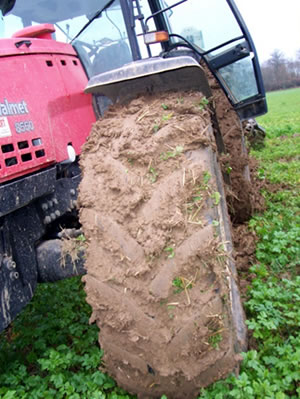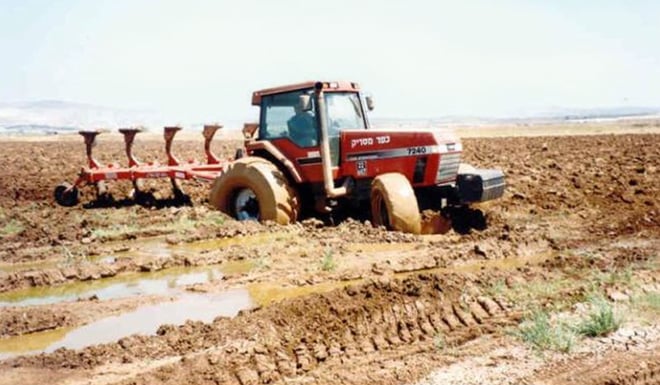Do you really know how to establish the right slip ratio for your tractor?
If the slip ratio is too low, the tractor cannot generate the right tractive force. On the other hand, if slippage is too high this will be very costly, since it increases your fuel consumption and wear to your tyres.
Slippage decreases your pulling power considerably
Your tractor’s pulling force depends on its power and weight. For efficient transmission of power, the connection to the ground, and as such the tyres, play an essential role. To obtain good traction and thus optimal power transfer, the full depth of your tyre lugs must be able to dig into the earth without slipping.
In the event of excessive slip, which is the slipping of your tractor tyres on the ground, there will be a net loss of tractive efficiency. This results in the wheel spinning more than the theoretical rotation (with total grip) necessary to cover a given distance. This slippage depends on the state of the two contact surfaces, i.e. the state of the tyre (new or worn) and the state of the ground (dry or wet).
How do you detect excess slip?
You can detect excess slip by observing the footprint left by the tyres in the soil. If the lug profile is not clearly defined or is much thicker than the actual lug width, this means the slip rate is high. An accumulation of earth between the lugs is also a sign of a high slip ratio and will generate a tractive effort that is much greater than usual.

Unsuitable pressure = High slip ratio
How do you estimate the slip ratio?
The slip ratio should normally be between 12% and 15%. This ratio is sometimes measured directly by captors which calculate the difference between the theoretical speed (measured on the drive shaft) and actual speed (measured by a radar).
If not, it can be calculated easily. To do so, drive your tractor over a given distance (100m for example) while another person counts the number of wheel rotations. Calculate the theoretical number of wheel rotations (distance / wheel circumference). Then use the following formula to establish the slip ratio:

Consequences: up to 20% extra fuel consumption linked to excessive slip
A slip ratio of more than 15% leads to horizontal sliding of the superficial layers of soil and damages the soil structure. In addition, the actual distance covered by the tyre, which is further than the distance driven by the tractor, leads to additional fuel consumption: 20% excess fuel consumption with a slip ratio of 30% to which premature wear of the tyres must be added.
How to reduce slip?
Slip depends essentially on the surface of the tyre in that is in contact with the ground and thus directly on the tyre inflation pressure. Unsuitable tyre pressure, such as an overinflated tyre, for example, will grip less because its footprint is reduced. The state of wear of the tyres is another crucial factor. The more worn the lugs, the less they “dig” into the ground.
One of the solutions to reduce the slip ratio is to adapt tyre pressure based on the tractor load. To do this, it is necessary to take into consideration the load applied to the tractor: a tractor with insufficient ballast will have less grip and a higher slip ratio if the tyre pressure is too high. A heavier tractor with the same load will have an acceptable slip ratio. Suitable pressure is pressure which allows adequate deformation of the tyre (a large enough tyre footprint) and allows the tyre to grip the ground. A slight decrease in inflation pressure from 1.25 to 1 bar for example (see photos above and below) may be enough.

Suitable pressure = Reduced slip ratio
Choosing wide tyres may also be a solution to increase the surface that is in contact with the ground.
You are then transporting an excess load which will have the same negative consequences as excess slippage (extra fuel consumption and premature wear of the tyres).
The Bridgestone-agriculture.eu blog is written and administered by tractor tyre experts who are available to provide you with the advice you need on the subject of your agricultural tyres. They allow you to maximise your productivity with information on all subjects linked to tyres: Technical data for agricultural tyres – Agricultural tyre performance – Air pressure advice – Solutions to avoid soil compaction – Sprayer tyre pressure – Why and how to ballast your tractor tyres – etc…
To take it one step further and increase the profitability of your farm, les Experts du pneu provide a free, highly detailed eBook which explains the essential role of the agricultural tyre in your productivity..
Most people who read this article have also read some of the following articles:
This information is intended only to make you aware of the technical and functional aspects of agricultural tires and their use. It does not allow you to make a judgment or a definitive conclusion on a given problem. Only your agricultural tire expert is able to make a technical assessment and take a final decision, case by case.
Leave a
commentary
Your email address will not be published.
Required fields are indicated with *








